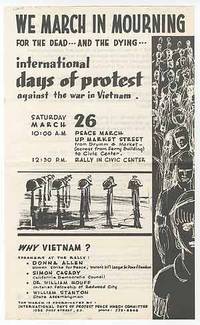 |
| My first demonstration The 2d Internationl Days of Protest |
 |
| The battlefield of the Ia Drang Valley - 1965 |
Holy Cross College was not Berkeley. But one day at Kimball Hall - where we checked our mail - was a group of people from the Catholic Worker movement, the communitarian pacifist group led by Dorothy Day. They spurred vigorous debate. What got my attention was that David Miller a Catholic Worker from Syracuse had challenged federal law by burning his draft card. He said, “I believe the napalming of villages is an immoral act. I hope this will be a significant political act, so here.” Miller was arrested, tried, and convicted. The conviction was affirmed on appeal despite the argument of his eminent ACLU lawyer Marvin Karpatkin that burning the draft card was protected expressive speech.
I began to regularly attend the Friday night talks at The Phoenix Club's store front on the fraying east end of Main Street in Worcester. I remember hearing Frank Wilkinson who had been jailed for refusing to answer the notorious question "are you now or have you ever been a member of the Communist Party". He refused to answer citing the first amendment and went to jail for it. He spent the rest of his days trying to shut down the House Un-American Actvitiies Committee.
Another Phoenix speaker was Jesuit Fr. Robert Drinan , the Boston College Law School Dean who would in 1970 join Congress on an anti-war platform. But the most memorable talk was by David McReynolds of the pacifist War Resisters League. After his talk we went back to the home of the eccentric Abbie Hoffman, a founder of the Berkeley Vietnam Day Committee which organized the first mass protests against the war. We watched black and white hand-held film of protesters blocking troop trains at the Oakland Army Terminal. We saw footage too of the thousands who in October had joined the International Days of Protest. I was very impressed by the international aspect which to me added legitimacy.
So I joined the second International Day of Protest in March 1966. With thirty or so others I marched in a circle in front of the War Memorial Auditorium. We carried signs protesting the war. Confronted by a similarly sized group denouncing us as communists, and threatening violence, the leaders instructed us to put down the signs and disperse. As I headed through the hostile crowd a fellow student was punched by a man with what we called brass knuckles that tore his face open. He needed surgery and I am sure he carries the scar to this day.
A year later momentum had shifted against the war. Instead of joining a modest group of picketers threatened by an angry mob, I met my girlfriend in New York for the massive April 1967 demonstration featuring Rev. Martin Luther King. We never did get to Dag Hammerskjold Plaza to hear Dr. King's speech because a cloudburst sent us scurrying for cover.
Two decades of work in the anti-war movement, and then the nuclear arms control movement would follow.
Some of your readers may be interested on my bibliography for the US war in Vietnam, Laos, and Cambodia, available at my Academia page (although I am not an academic): https://www.academia.edu/5121042/Vietnam_War_select_bibliography
ReplyDelete